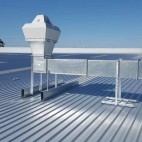With many environmental threats lagging around, particularly climate change which is caused by emissions from coal power stations and other pollutants. It is imperative to cautiously meet today’s needs, without compromising tomorrow’s future. There is a major global energy transition, shifting the way electricity is generated and supplied. We are taking a closer look at the trends surrounding renewable energy systems in South Africa.
Our environment is not timeless or inexhaustible, fossil fuels will expire but the adverse effect they have on our environment such as pollution will be ever-lasting. It is our responsibility to ensure biological systems endure and remain productive for future generations to come. The broad discipline of sustainability has gradually shifted the human world, particularly our attitude across multiple industries.
The way we look at the world is with closer inspection, in terms of formulating or generating habits that can maintain the environment at a certain rate or level, otherwise, we risk being confronted with battling against depleting resources. This is because over time, especially before the industrial period, the global average land temperatures almost doubled. This can all be attributed to the larger heat capacity of oceans because oceans lose more heat through evaporation.
Since global warming is the gradual increase in the overall temperature of the earth’s atmosphere, that is generally attributed to the greenhouse effect caused by increased levels of carbon dioxide and other pollutants. It is important for communities to get a tumultuous reminder of how our actions could lead us to our demise. This is why businesses and organisations in the modern world, be it in business, the technology environment, the social sciences environment are incorporating or formulating ways to drastically reduce carbon emissions and develop technologies that can assist in successfully achieving a healthy sustainable environment.
This has helped pave the way for newly desired skills and create an emerging field of employment altogether. Which then brings us to the issue of energy
Sustainable energy, also known as clean energy does not cause any harm to the environment, it is the practice of using energy in a way that meets the present needs of today’s society without compromising the needs of future generations to come. There are many forms of sustainable energy and among them are the following predominant renewable energy sources: solar, wind, geothermal, hydropower and hydroelectric energy.
The goal of halting the use of fossil fuels can be achieved by making use of replenishable energy that helps reduce greenhouse emissions currently damaging our environment. So, what are these fossil fuels? Fossil fuels usually include gas, coal and oil.
In ancient times biomass was the only way to get energy, with waste products, wood, timber serving as the effective and predominant energy sources. The advancement and development of technology opened a door to fossil fuels like oil, coal and the discovery of natural gas. What made them so fascinating was their widely available nature combined with their potential to be harnessed easily. Unfortunately, they were a wolf disguised in sheep’s clothing as they immediately started causing degradation to the environment.
One interesting fact is that oil and coal are two of the major sources that produce large amounts of carbon dioxide in the air, causing global warming. A limited number of countries is in possession of large quantities of these valuable products, causing them to have a high price. The effects of these fossil fuels are what caused scientists to look for resources that are widely available, accessible and at the same time reasonably priced.
At the moment 20% of the world’s energy comes from renewable energy sources. Sustainable energy is not limited to renewable energy sources, it encompasses sources of energy that can be used to power homes and industries without any harmful effects being experienced. Its effects are purely beneficial to the environment.
South Africa has made several strides in innovation and advances in renewable energy systems. However, the energy demand in South Africa is expected to rise possibly doubling by 2025. Even though progress has been made in our country in comparison to other African countries, more still needs to be done. The main barrier we face with regards to increasing the number of renewable energy systems is the high cost of new and available technologies.
Renewable energy systems are initially costly to install, long term they are not only sustainable but provide high economic returns. Renewable energy in South Africa focuses on four key areas: electricity generation, air and water heating/ cooling, transportation and rural energy services.
Renewable energy in South Africa is obtained from renewable resources that naturally replenish themselves such as sunlight, wind, tides, rain, biomass and geothermal heat. Biomass currently serves as the largest renewable energy contributor in South Africa with 9-14% of the total energy mix.
South Africa receives large amounts of radiative energy because of its geographic location, this radiative energy is used to generate solar energy. Wind energy is another predominant source of renewable energy used in the country, this wind energy comes from the high velocity on the coast of the country. Cape Town has implemented several wind farms and they are successful in generating low amounts of electricity for residents.
The following are the sustainable energy alternatives currently being made use of in the energy sector in South Africa: Solar Power, which is generated through photovoltaic (PV) solar panels. Solar panels convert the sunlight into electricity. This option is very viable across multiple countries, solar power systems are the main source of sustainable energy sources being installed in many countries.
New technology has made solar panels more effective than older systems. To date, 16% of the sunlight is converted into electricity. As new technology is developed, it will improve the efficiency of solar systems and this improvement will ensure solar power plays an even greater role in the energy mix.
Solar Heating: It is the conversion of sunlight into renewable energy for water heating. This is done by using a solar thermal collector, a solar thermal collector has multiple functions, it can also be used to cook food in a solar oven. Solar heating is a cost-effective method and significantly saves electricity.
Investing in solar heating will ensure you use less electricity, while at the same time it will give you the liberty to have a functional life by only purchasing a regular solar power system, it can also be used to heat up pools. A solar oven uses energy from the sun to cook food, by directing the sunlight into a solar oven, this increases the temperature to heat high enough to prepare a good meal. This sustainable solution is especially helpful in areas where there is very little access to other energy resources, meaning it is very convenient for many parts in Africa.
Solar Tubes and Skylights: Several houses have areas like passages, and passages tend to be dark because they don’t have enough windows or light coming in. Instead of switching on a light, installing a skylight or a solar tube will ensure natural daylight shines through your house, giving your home natural light. Some tubes have a natural ventilation system installed, this is good for places like bathrooms without windows. It is apparent that there are multiple ways to harness energy from the sun, and that the sun can give any space the illusion that its daytime all the time for those who especially don’t like the dark.
Wind Power: It has been harnessed for centuries, in the form of commercial shipping and windmills to mill grain and pump water. These days wind power is successfully used to generate electricity through wind turbines and to pump water using wind pumps. Wind energy is one of the fastest-growing sources of electricity in the world and it is quite easy to understand why. Wind energy does not pollute or contaminate the surrounding area on which it is built. In addition, one turbine is capable of generating power for over 500 households. The only problem associated with wind power is that at times birds get caught in the turbines. Damaging equipment.
Hydro Power: This is energy that is generated by the movement of water. Energy gets generated through water falling or flowing down a river, that water is channeled through a turbine. Flowing water was used in ancient mills to power various machines, from saws to cranes, mills and so much more. Most hydro-power requires the building of dams and reservoirs. This can have an adverse effect on the environment and displace many people, as a result, a lot of research and environmental planning has to be done before building a dam. Hydropower source energy is produced from the movement of ocean waters, through tidal waves, this is often referred to as marine power.
Geothermal Energy: Is energy generated by using or drilling into the thermal energy or heat generated at the Earth’s core. This energy can easily be harvested at tectonic plates and by drilling deep into the ground then pumping in heat transfer fluids like water or steam.
Sustainable energy systems are indeed the future, here is a short list of some companies in South Africa currently specialising in that field: Eco-efficiency in Randburg Gauteng which offers the following services: installation of solar power solutions for mobile, residential and commercial applications, they also have portable solar power solutions for outdoor activities like camping. Then I Power SA which is located in Cape Town, they offer the following services: Renewable Energy Assessment and Design, Lighting and LED Supply, Remote Power Solutions, Solar Products, Engineered Macro and Hydropower.
Batteries and Solar Inverters, located in Brackenfell Western Cape, they specialise in A to Z Solar supplies and are a registered Solar Installer, Deep Cycle batteries: Gel, AGM, Calcium, Energy management and consulting, Grid-tied and Hybrid Inverters, Charge Controllers and much more. EasySolar Energy House in Richards Bay, Kwa-Zulu Natal, which specialises in solar energy housing supplies. It is the prime South African solar energy supplier; their product range includes solar geysers and heat pumps for domestic and commercial hot water supply.
NRG Technologies in Centurion Gauteng: NRG Technologies supplies Solar Products, LED Lights, Deep Cycle Batteries and Inverters, they also encourage Residential and Commercial Industrial sectors to become more energy efficient. Solar Energy Group in Pretoria, which is an importer and exporter, wholesaler and reseller of top-quality leading brands of solar and renewable energy generation equipment and components.
Harness Solar Power CC, Cape Town, are are an established alternative energy company which offers a wide range of energy-producing solutions and energy-saving services. PVStore in Sandton is an integrated energy company offering services such as Solar Equipment sales and Installations, Energy management systems and energy consultancy.
To conclude sustainable and renewable energy systems are everywhere around us, they can be installed on things we use daily and quite easily become our best friend.
It might be slightly expensive to get these alternatives at first but what price are you willing to pay to ensure your children, their children and future generations to come have the same basic needs you have today? Renewable energy solutions are beneficial to the environment and have successfully managed to create employment across the country.
Jacquiline Manyonga










